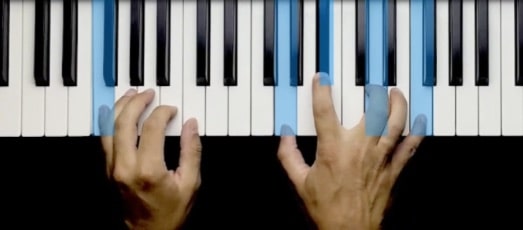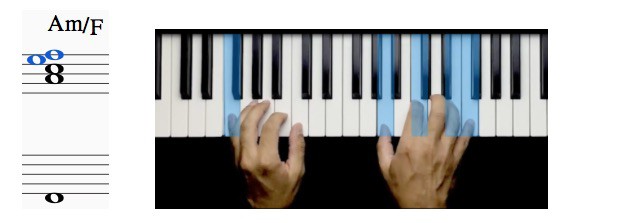This month the ‘King Of Pop’, Michael Jackson, would have become 60 years of age.
Dearly missed, not only his fans will remember and celebrate his outstanding talent on this occasion.
We at Skoove honour Michael with an arrangement of one of his super hits:
Heal the World.
In this blog I will teach you some techniques on how to create your own intro for almost any piano song. And who, if not one of the best songwriters of all times, Michael Jackson, would let us borrow some chords from his song ‘Heal the World’?!
?Tip: Get the best out of this blog post by studying the basic arrangement of Heal the World in Skoove’s Beginner Song Section.

Watch the reference video here:
- Slashed Chords
?Tip → Video minute 0:01:
The intro of ‘Heal the World’ offers three triads in succession. The order of these chords is very popular and many other hit songs are based around this chord progression, too.
The three chords go like this:
- F-major (F)
- G-minor (Gm)
- A-minor (Am)
These triads are neighbouring triads, one chord is located next to the other:

?Tip:
Get in front of the piano now and play these three chords with the right hand. Use the fingers that feel most convenient for you. It may take some time, until you manage to play the keys for each chord simultaneously, but the practice is worth it!
?Even easier: Learn this chord progression in the key of C with Skoove’s Chords & Scales course
Once you are familiar with the chords, play them in an ascending and descending order as shown here:

? Tip:
To get the harmonic journey as you hear it in the intro of my arrangement, we now need to simply add the low F in the left hand below every chord.
Simply play the F-major-triad over F, the G-minor-triad over F and the A-minor-triad over F.
Written as chord symbols it looks like this:

The letter left to the slash is the chord you play in the right hand.
The letter right to the slash is the bass note you play in the left hand.
Because the slash is used in this chord symbol, these chords are called ‘slashed chords’.
?Written as notes in the score, the slashed chords look like this. The continuously played note of F in the bass is marked blue:

When you play the slashed chords as written, you should get already quite close to the sound of the intro I am playing in my arrangement.
?This chord progression works in any major key to create a short and beautifully sounding intro. To save you thinking time, here’s a list with the above chord-progression for the most common keys:
In C-major: C – Dm/C – Em/C
In G-major: G – Am/G – Bm/G
In D-major: D – Em/D – F#m/D
In F-major: F – Gm/F – Am/F
In Bb-major: Bb – Cm/Bb – Dm/Bb
- Extend your chords
?Tip → Video minute 0:09
When you look closely at my fingers in the video, you will see, that I am doubling the F-bass note with the pinky of my right hand. I play the F on top of each of the chords. You can see the F indicated in blue in the note score below.

Below in the screenshot you see me playing the Gm/F with the added F-key on top of the chord. The experts among you will know, that it is a Gm7/F chord.

Chords with extensions sound fuller and often offer some surprising harmonic beauty. Some chords will change to sounding sweeter, some saltier, but in a total- like played in the intro – they can provide a very tasty overall sound.
?Tip: Learn more about chords and chord accompaniment in Skoove’s Intermediate 2 Course and Chords & Scales Course.
- Harmonic Tension & Friction
Even if some of the extended chords may sound piercing to our ears when played on their own, in the harmonic context they can make perfect aural sense. I often compare the process of composing with cooking. Often a tiny bit of salt or chilly adds magnificently to the overall flavour, whereas a huge portion of these ingredients may taste very off-putting. It is the same with creating a harmonic journey. So I very consciously used some “salt” in the intro to the Heal the World – arrangement.
The ‘salt’ inside the chords of the intro is undoubtedly the Am with an added F on top. In the score below and indicated in blue, you see the reason: The E and the F on top of the Am/F chord add friction. Both notes played together form the interval of a minor second, known as an interval of tension.
In harmonic context however, this friction is exactly what is making the chord progression sound so beautiful.
(The experts among you may argue, that this chord could be easier interpreted as an F major 7th chord, and I’d agree, however the concept of friction remains the same.)

?Remember: Tension & Release are the most fundamental drivers for harmonic progression in western music. It is the harmonic friction that creates this tension.
- Rhythmetize your chords
?Tip:
The rhythmic element of your intro is really important to make it sound interesting.
So far you may have played the chord tones without much rhythm.
One easy technique to get more rhythm and groove going in your playing is to arpeggiate the chord you play.
Arpeggio means that the chord tones are played in succession.
Playing chord tones arpeggiated (also called melodically) is actually easier than playing them simultaneously (also called harmonically), because you play one finger at a time as opposed to all of them at the same time.
Here you see the notation of a chord arpeggio of the intro chords. The notes are played in succession as quarter notes.
Even simple, this arpeggio already adds a rhythmic element to the intro.

?Tip:
Play the arpeggiated chords on the piano.
IMPORTANT: Use the sustain pedal or every arpeggiated chord as indicated by the blue lines.

Surely arpeggios can rhythmically be more complex… the sky’s the limit. However, start out with a simple rhythmic pattern and apply it to every chord. Don’t use a different rhythmic pattern for each different chord as it may sound confusing and off.
?Tip:
Become creative with the order of notes in the arpeggio. Simply change the order of chord tones. Here is an example:

Send me your intro!
If you apply some of the tips & tricks from the blog post, you surely will have created your own fabulous intro to ‘Heal the World’ or other songs. I would LOVE to hear it. If you like to, send a link of your recording to music@blog.skoove.com .
I hope this blog post was useful for you. Looking very forward to your comments.
Happy playing,
Dominik
Try out your free trial of Skoove today!














